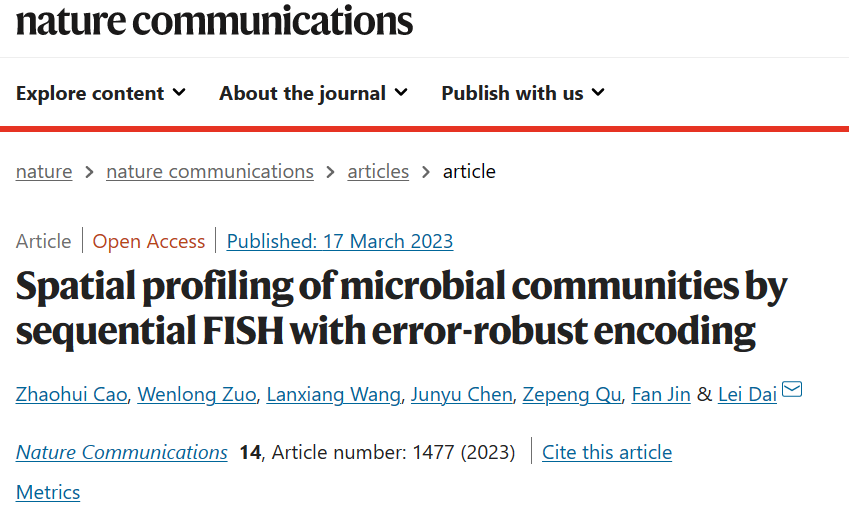
On March 17, 2023, Dai Lei's research group of the Synthetic Microbiome Research Center of Shenzhen Institute of Advanced Technology, Chinese Academy of Sciences, and Shenzhen Institute of Synthetic Biology, published the latest research results of imaging-based space microbiome on Nature Communications, a sub-journal of Nature, under the title of “Spatial profiling of microbial communities by sequential FISH with error-robust encoding”. The team developed a sequential error-robust fluorescence in situ hybridization (SEER-FISH) technique for analyzing the spatial structure of complex microbial communities. This method can identify different microbial species in complex communities, and analyze in situ the interactions between microbial species as well as between microorganisms - hosts at the single-cell scale. It is an important tool for studying the ecology and function of microbial communities. Team members, Cao Chaohui, a doctoral candidate, and Dr. Zuo Wenlong, are co-first authors, and researcher Dai Lei is the corresponding author of the paper.

Screenshot of the published paper
Link of the paper: https://doi.org/10.1038/s41467-023-37188-3
The microbial communities in nature have rich species diversity, and the unique survival modes and interactions of various microorganisms constitute the specific spatial structure of a community. Although existing high-throughput sequencing techniques can characterize the species composition and abundance of microbial communities, there is still a lack of powerful tools for analyzing the spatial structure of communities. Since the number of species that can be distinguished by conventional fluorescence microscopy is limited by the color variety of fluorophores, mapping the spatial structure of complex microbial communities with high species resolution remains a major challenge. Based on this, the research team developed a new SEER-FISH imaging technology and applied it to complex microbial communities, plotted the spatial distribution of microbial communities colonized in Arabidopsis thaliana roots at the micrometer scale, and observed spatial heterogeneity colonization of different species on the root surface, as well as changes in spatial distribution and spatial correlation of species after being disturbed by host metabolites. SEER-FISH technology can accurately analyze the spatial structure of complex microbial communities, providing a powerful tool for studying the ecological laws and physiological functions of the symbiotic microbiome in hosts such as plant rhizosphere and human gut.

Figure | Plant Rhizosphere Microbiome Photographed by SEER-FISH
SEER-FISH analyzes the spatial structure of microbial communities by sequential fluorescence in situ hybridization. The working principle is to assign a specific multicolor code to each microorganism, label the corresponding microorganism with an oligonucleotide probe with fluorophores with corresponding color in each round, and then obtain the multicolor code of each cell through multiple rounds of fluorescence in situ hybridization imaging to determine its corresponding species (Figure 1a-c). Further optimize the code. Error-correcting codes with different hamming distances (HD) can improve the accuracy of species recognition rate and are highly scalable (Figure 1d).

Figure 1 Working principle of SEER-FISH multi-round imaging
The research team first conducted a systematic evaluation of SEER-FISH technology in vitro imaging experiments of different microbial communities. The experiments verified the accuracy and repeatability of this method in identifying community composition, which could accurately quantify changes in community species composition (Figure 2a-c). The community composition obtained by different coding schemes was highly consistent (Figure 2d f).

Figure 2 SEER-FISH can accurately analyze the composition of complex microbial communities
The plant rhizosphere is colonized by highly diverse microbial communities, which are regulated by the plant host and affect the physiological health of the plant. However, we know little about the spatial structure of rhizosphere microbial communities. The research team applied SEER-FISH to spatial imaging of root surface microorganisms and outlined the composition of microbial communities distributed and colonized in different physiological zones (Figure 3a-c). The research team found that the microbial communities colonized on the root surface were not randomly distributed, but tended to form aggregates. These microbial aggregates ranged in size from tens to hundreds of microns and exited in multiple species (Figure 3d-f). There were various hypotheses regarding the specific reasons for the formation of microbial aggregates, including preferential colonization and improved adaptability in the rhizosphere environment. In addition, significant bacteria - bacteria spatial correlations were found through proximity analysis of microorganisms in the community (Figure 3g).

Figure 3 Analysis of microbial communities colonized on the root surface of Arabidopsis thaliana at the single-cell level
By adding exogenously the metabolites camalexin and fraxetin secreted from the rhizosphere of Arabidopsis thaliana, the research team found significant changes in the composition and spatial distribution of rhizosphere microorganisms (Figure 4a-c). For example, Sinorhizobium was mainly colonized near the root tip, and such preferential colonization changed after camalexin and fraxetin were added (Figure 4d). The colonization of agrobacterium itself in the root was not preferential, but after being disturbed by fraxetin, agrobacterium was more colonized in the maturation zone of the root (Figure 4e). The high heterogeneity of the spatial distribution of rhizosphere microorganisms and the differences between species were related to environmental heterogeneity and the characteristics of microorganisms themselves. By further analyzing the spatial correlation of colonized microorganisms, it was found that both camalexin and fraxetin affected and changed the spatial correlation between species to different extents (Figure 4f). The spatial correlation at the micron scale implied the widespread short-range interactions (such as nutrient competition and syntrophism, contact inhibition, quorum sensing, etc.) between different species in microbial communities, which had important guiding significance for further mechanism research.

Figure 4 Analysis of the impact of metabolites secreted from the rhizosphere of Arabidopsis thaliana on the spatial distribution of microbiome
This work was sponsored by the National Key Research and Development Program (No.2019YFA0906700), the National Natural Science Foundation of China (No.31971513, No.32061143023, No.32100072), the Guangdong Natural Sciences Foundation (No. 2022A1515011513), and Shenzhen Institute of Synthetic Biology.